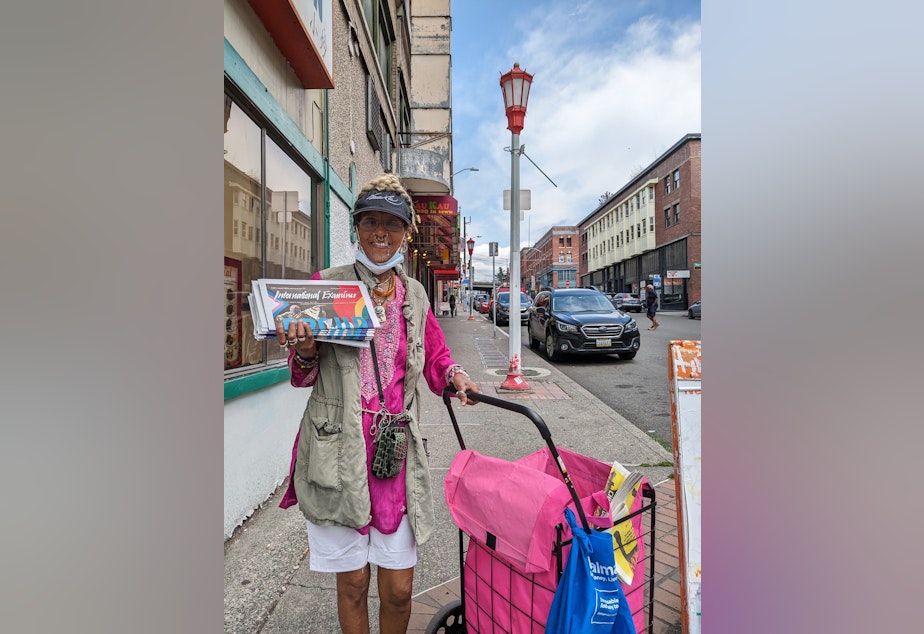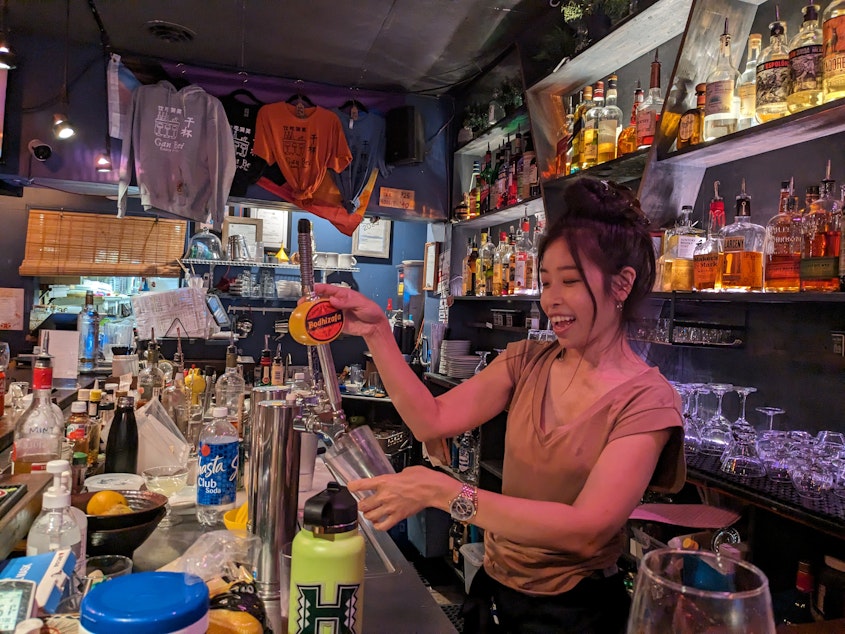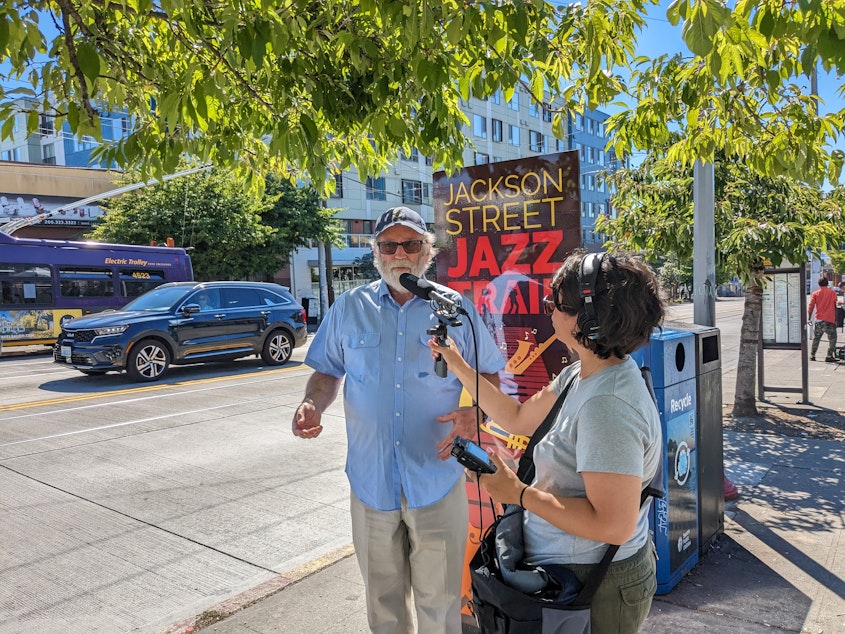These neighbors are the heartbeat of Seattle’s Chinatown-International District

Everyone in Seattle's Chinatown-International District has a story that contributes to the neighborhood’s rich historical and multicultural significance. While it isn’t possible to catalog every individual story that makes up this place, we curated a series of profiles that showcase the layers of life that exist in this place.
An Ethiopian immigrant finds a new sense of place, a young restaurant manager faces the complexity of owning a business with your family, and finally a jazz historian uncovers how jazz once ruled the intersection at 12th and Jackson.
“This is like a little Africa.” —Alganesh Tewelde on life in the Chinatown-International District
A
lganesh Tewelde was born in Ethiopia and came to the United States in the 1980s. She now calls the International District home and lives at Hirabayashi Place. She loves being involved in her community and began delivering issues of the International Examiner to local businesses in the neighborhood.
Sponsored
She travels the same route, but it wasn’t easy to follow at first.
“I didn’t know where I was going, but…now I am learning it,’ she says. ‘I am knowing more people. All they need to know is my name.”
Growing up in Ethiopia, being part of a multicultural community is nothing new for her. She was used to seeing people from Japan, Korea, China, and other countries.
“The culture is similar. So basically I am comfortable to be around multidiversity,” she says.
Sponsored
The community spirit of the Chinatown-International District resonates with how Tewelde grew up as well. Without an abundance of resources, it was normal to lean on networks of care and to pitch in with neighbors. She continues that ethos now, and is finding acceptance here. Sometimes the language barrier is a challenge, but she knows she belongs.
“This is just the beginning for me,” she says. “ It feels like I am home. This is a little Africa — for real! Yeah, you meet people and you learn about each other, and then you live together in harmony.”

“You can’t not love this place because of the people.” —Yen Ma, co-owner of Gan Bei Eatery and Bar on her patrons.
Gan Bei Eatery and Bar is cozy. The lighting might be dark but the furniture and colors of the walls make it feel warm. There’s a bubbling fish tank near the door, and further back, on certain nights, people wait for their turn to sing karaoke.
Sponsored
Watching over everything is co-owner and manager, Yen Ma.
Gan Bei means “bottoms up” in Mandarin, which Ma says is unusual given that most of the Chinatown-International District is Cantonese, and more specifically Taishanese. Taishan is a region in China and is home to the first waves of Chinese immigrants who came to America.
Taishanese cuisine is a bit different from what Americans consider as Chinese food. Ma points to some common ingredients: XO sauce, a seafood tasting, umami flavored sauce, turmeric, cumin, fermented shrimp paste, sweet potato vine, and a fermented soybean called furu.
RELATED: For family-run businesses in Seattle's Little Saigon, the next generation holds the keys
One of her favorite dishes is goji berry, lotus leaf, and chicken with red dates.
Sponsored
“The bone is where the chicken wing is,” she says. “You cut in between a bowl until it becomes like a shard. It was like the most dangerous food to eat growing up. But I just knew the flavor was so good.”
Ma describes Taishanese food as herb flavor-forward. The meat is but a carrier. These are the flavors she presents at Gan Bei.
The head cook behind it all is her father. But he’s so much more than that.
“At the end of the day, he had to wrap up the kitchen and had to have a smile on his face when he sees our regulars,” Ma says. “He's a big part of our brand. His food is everything to rave about.”
Ma pours love into this place — she remembers everyone’s name. And the people love this place right back.
Sponsored
“You can't not love this neighborhood because of the people,” Ma says.
They are the reason she comes back, day after day.
“...the fountain of the richest cultural legacies that we have in the whole history of our city.” —Paul de Barros on Little Saigon's notorious 12th and Jackson

The Chinatown-International District’s 12th and Jackson intersection has become associated with public safety issues over the past several years. But once upon a time, it was the heart of a thriving jazz scene in the city.
“In fact, this was the fountain of the richest cultural legacies that we have in the whole history of our city,” says Paul de Barros, a local historian and journalist who has researched and chronicled the history of Jackson Street’s music scene for years.
The musicians and patrons he’s interviewed have described this corner as being incredibly lively in the 1930s and 1940s.
Politicians would ride up in limousines, and prize fighters and glamorous women, decked in pearls and boas, would fill the streets. One of the most popular spots was the Black and Tan Club. de Barros calls it the center of the scene.
The club’s founder wanted the spot to be a place where people could talk about social issues. The neighborhood was a multicultural place, where Black families lived alongside Japanese and Chinese families.
“There was a really symbiotic relationship and a friendly relationship,” de Barros says.
Railroad workers and laborers would stay in the area for short periods of time in between trips. They would hang out at the Black and Tan.
“It was called the Black and Tan because a ‘black and tan’ is a generic name for a club where Blacks and whites mixed,” de Barros explains.
Many great figures of Seattle jazz history played at the club, like Oscar Holden. Ray Charles played the Black and Tan from time to time as well, and ended up being a regular performer at the Rocking Chair up on 14th.
“This is a really fun scene to be nostalgic about. There was a degree of racial mixing that seems really idyllic in our day and age,” de Barros says. “But the pillars on which this whole system rested was very shaky.”
Illegal liquor, payoffs, and corruption created the circumstances for this area during prohibition. Once alcohol was legalized and accessible all over the city, 12th and Jackson died down as patrons went to other parts of the city for nightlife, according to de Barros.
Racial segregation across Seattle also contributed to the jazz clubs on 12th and Jackson thriving, he says. But after segregation was outlawed, Black musicians were able to play at downtown clubs, which dispersed the local jazz scene even more.
Correction notice, 2:25 p.m. on Monday, 09/18/23: A previous version of this story misstated one of the ingredients found in Gan Bei Eatery and Bar. This story has since been updated to reflect the correct list of ingredients.





